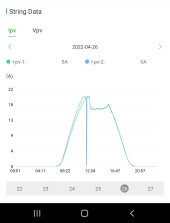True Robby, but that PV just stretches that 3 days to 4 or maybe 5. The self load increase still eats into it. I learned about the “grey days of November” ( I think my mother called it) last year; almost no PV output for days at a time…dark, dark clouds. November and even December, long stretches of very little PV causing me to make special trips to run my generator.
I fear it being incrementally worse this year or next if forced to take an upgrade. Of course, a whole home generator would solve that, or even more PV, but there is only so much money to go around!



